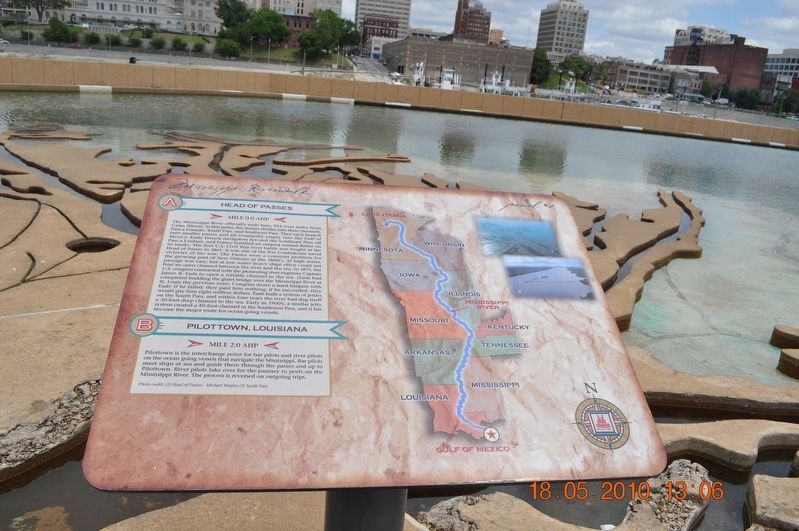Memphis in Shelby County, Tennessee — The American South (East South Central)
Head of Passes/Pilottown, Louisiana
Panel #1 Mississippi Riverwalk
A) Head of Passes
Mile 0.0 AHP
The Mississippi River officially ends here, 954 miles from Cairo, Illinois. At this point, the stream divides into three channels, Pass a Louture, South Pass, and Southern Pass. They each branch into smaller passes and all eventually empty into the Gulf of Mexico. Early French navigators favored the Southeast Pass off Pass a Louture, and France fortified an outpost named Baliz on its banks. The first U.S. Civil War battle was fought at the Head of Passes in 1861. It was one of the few Confederate naval victories of the war. The Passes were a constant problem for the growing port of New Orleans in the 1800’s. At high water, a passage was easy, but at low water heavy ships often could not find an open channel between the river and sea. In 1875, the U. S. Congress contracted with the pioneering river engineer, Captain James B. Eads to open a reliable channel to the sea. (Eads had completed building the giant bridge over the Mississippi River at St. Louis the previous year.) Congress drove a hard bargain with Eads: if he failed they paid him nothing; if he succeeded they would pay him eight million dollars. Eads built a system of jetties on the South Pass, and within four years the river had dug itself a 30-foot-deep channel to the sea. Early in 1900’s, a similar jetty system created a 40-foot channel in the Southwest Pass, and it has become the major route for ocean-going vessels.
B) Pilottown, Louisiana
Mile 2.0 AHP
Pilottown is the interchange point for bar pilots and river pilots on the ocean-going vessels that navigate the Mississippi. Bar pilots meet ships at sea and guide them through the passes and up to Pilottown. River pilots take over for the journey to ports on the Mississippi River. The process is reversed on outgoing trips.
Erected by Mississippi Riverwalk. (Marker Number 1.)
Topics. This historical marker is listed in these topic lists: Exploration • Forts and Castles • War, US Civil • Waterways & Vessels.
Location. 35° 8.968′ N, 90° 3.507′ W. Marker is in Memphis, Tennessee, in Shelby County. Marker can be reached from Island Drive, 0.8 miles south of West A.W. Willis Avenue when traveling south. Located at Mud Island River Park. Touch for map. Marker is at or near this postal address: 125 N Front Street, Memphis TN 38103, United States of America. Touch for directions.
Other nearby markers. At least 8 other markers are within walking distance of this marker. The Mississippi Riverwalk (here, next to this marker); Ohio River (here, next to this marker); Cairo, Illinois (here, next to this marker); Islands No. 2, 3, and 4 / Fort Jefferson, Kentucky / Bird’s Point, Missouri (here, next to this marker); Island No. 5 (Wolf Island)/Belmont, Missouri/Columbus, Kentucky (here, next to this marker); Donaldson Point, Missouri/Island No. 8/Hickman, Kentucky/Dorena Crevasse (here, next to this marker); New Madrid, Missouri/Cates Casting Field/Island No. 10 (here, next to this marker); Tiptonville, Tennessee/Bixby Towhead (here, next to this marker). Touch for a list and map of all markers in Memphis.
Also see . . .
1. Head of Passes. During the American Civil War, Head of Passes was the site of several naval battles. The Anaconda Plan called for a large Union blockade of the Confederacy, and included plans to control the Mississippi River. This began in 1861 with a Union blockade stationed at the Head of Passes. This occupation resulted in the Battle of the Head of Passes, where the blockading forces were temporarily driven from the area. Ships involved in the ensuing conflict at the location include the CSS Manassas, the USS Vincennes, and the USS Richmond. (Submitted on March 12, 2018, by Sandra Hughes Tidwell of Killen, Alabama, USA.)
2. Pilottown, Louisiana. Pilottown was constructed and settled after September 1860 in its current location. It replaced the earlier village of La Balize, that had been founded more than 160 years earlier downriver. After the hurricane of September 14–15, 1860, blew its buildings down and destroyed the area in a storm surge, La Balize was finally abandoned. The main river passage was moved to the Southwest Pass, because of its deeper water. The Mississippi River pilots built their new settlement upriver above Head of Passes. They named it Pilottown. (Submitted on March 12, 2018, by Sandra Hughes Tidwell of Killen, Alabama, USA.)
Credits. This page was last revised on March 13, 2018. It was originally submitted on March 12, 2018, by Sandra Hughes Tidwell of Killen, Alabama, USA. This page has been viewed 400 times since then and 75 times this year. Photo 1. submitted on March 12, 2018, by Sandra Hughes Tidwell of Killen, Alabama, USA. • Bernard Fisher was the editor who published this page.
Editor’s want-list for this marker. Wide shot of marker and its surroundings. • Can you help?
